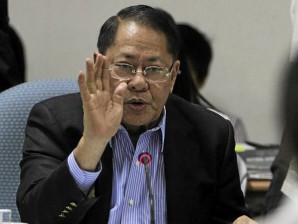Luzon power crisis looms—Angara
The energy shortage that Mindanao is experiencing will hit Luzon in two years unless the Aquino administration taps more renewable energy sources, Senator Edgardo Angara warned Sunday.
Angara assailed what he called the “feet-dragging” of the administration—and also of the administration of former President Gloria Macapagal-Arroyo—in fully implementing the 2008 Philippine Renewable Energy Act.
“Luzon will [experience] its own crisis in two years’ time unless we open up our renewable energy sources,” Angara said in an interview over dzBB radio.
Also on Sunday, the environmental group Greenpeace reminded President Benigno Aquino III of his campaign promise to promote renewable energy and increase the share of cleaner technologies in the country’s energy mix.
Greenpeace has bucked proposals to give the President emergency powers to solve the power crisis in Mindanao. The group instead urged Mr. Aquino to press the implementation of the renewable energy law to deal with Mindanao’s problem.
Article continues after this advertisementThe only power
Article continues after this advertisement“The only power President Aquino needs right now is the power to make good on his commitments when he was elected,” said Von Hernandez, Greenpeace Southeast Asia executive director.
“During his campaign for the presidency, Mr. Aquino declared he [was] for the phaseout of coal power plants in the country. Unfortunately, he seems to have forgotten his promise, allowing the implementation of the [renewable energy] law to drag on and letting coal plant proposals get through left and right.”
Campaigning in 2010, Mr. Aquino said “the country must seriously move toward a clear shift to clean energy and technologies.” Greenpeace said the President made the statement in response to the “Green Electoral Initiative” survey of Greenpeace and the EcoWaste Coalition. He also committed to increase the share of renewable energy in the country’s energy mix to at least 50 percent within the next 10 years, with the full implementation of the Renewable Energy Act.
Presidential deputy spokesperson Abigail Valte said she would talk to Energy Secretary Jose Rene Almendras about implementing of the renewable energy law and bringing Angara’s warning to his attention. But she noted that Luzon still had a power surplus.
Angara said proponents of renewable energy anticipated the “incoming storm”—that the country might not be able to support industrialization purely on imported crude—at least four years ago.
Back then, he said, some $5 billion in fresh investments in renewable energy were lined up. But the investors moved to neighboring countries like Indonesia, Thailand and Cambodia because the Philippine government failed to determine how much a renewable energy generator would earn, Angara said.
Now, he said, $1 billion in renewable energy investments, including investment from European companies, are “ready to come in.”
But the government has not fully enforced the renewable energy law to encourage full development. “We’re always late, we always move at the last minute,” Angara said.
Ambiguous, confused
The administration’s renewable-energy policy, Angara said, is “very ambiguous.”
“The policy laid down by the law is clear, but it seems that the implementers themselves are confused,” Angara said in Filipino.
The power shortage in Mindanao, he said, could be traced to the government’s failure to sufficiently invest in renewable energy. “That’s the cause of this crisis, we jogged around in terms of renewable energy,” he said. “This is our long-term solution, because [our renewable energy reserves are] sufficient to cover all our energy needs.”
According to the Department of Energy, about 35 percent of the country’s energy comes from renewable sources such as water, geothermal gas and biomass. The Renewable Energy Act aims to attract investors to put up other clean technologies, such as wind and solar farms.
But the implementation of the government’s renewable energy policy is slow, according to Greenpeace and other environmental groups like Worldwide Fund for Nature-Philippines.
